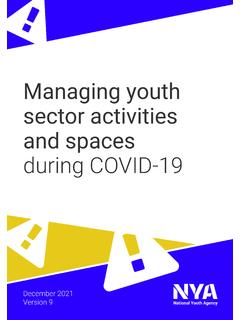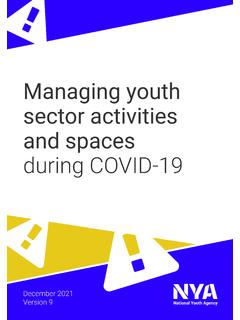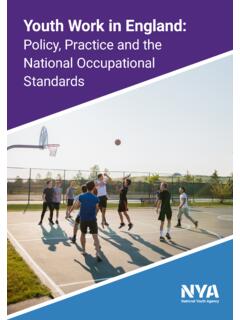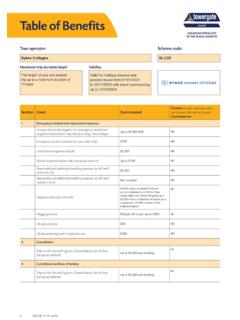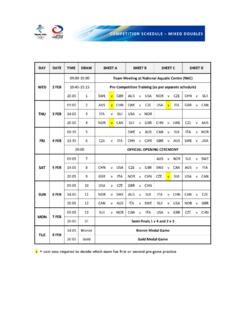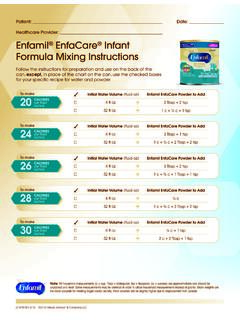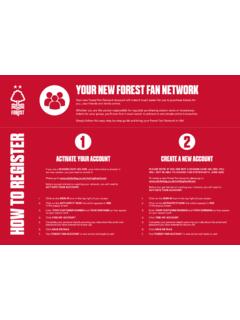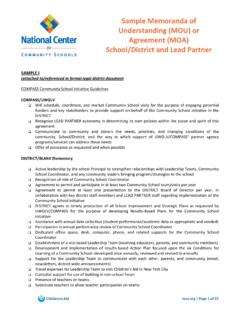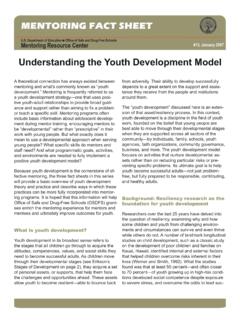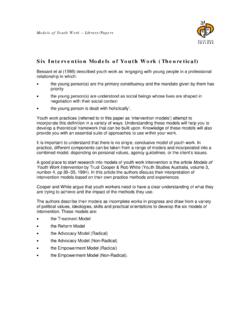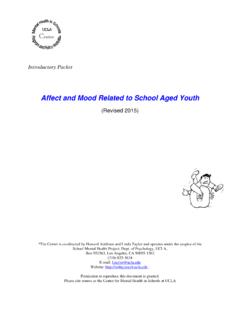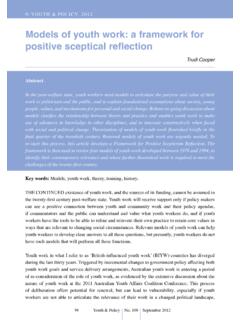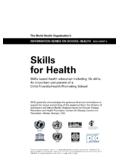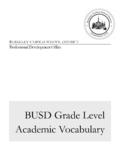Transcription of National Youth Work Curriculum
1 National Youth Work Curriculum National Youth Agency Version 1 | Sept 2020. Acknowledgements We would like to thank the people that have helped to think about, consider and develop this Curriculum . The learning group who met to debate and agree what we meant by Youth work and the values and principles of Youth work, and most importantly developed the model on which this Curriculum is founded is detailed below: Esther Horner Kinetic Keni Thomas Youth Work Specialist Christine Smith - TAG:PALYCW. Kayleigh Wainwright - UK Youth Stuart Dunne - Youth Focus NW. Kevin Franks - Youth Focus NE. Bethia McNeil - Centre for Youth Impact Jon Ord - Plymouth Marjon University Juliette Morgan - Youth Focus SW. Gill Millar - Chair ETS. Ruth Rickman Williams - Youth Focus WM. Leigh Middleton - National Youth Agency Abbee McLatchie National Youth Agency Lots of Youth workers and young people were part of the reflective process and helped think through ideas, thank you to them. Our thanks to Liz Harding, the Lead Associate that led this project to fruition.
2 NYA would like to thank the Department for Culture, Media and Sport for supporting the development of this Curriculum . Inspiration comes from the great practice that exists and the inspirational young people who have participated in it. Contents Foreword 4. What is Youth work and its Curriculum ? 5. Introduction 7. How can this document be used? 8. Explaining the model 9. Cornerstones of Youth work 9. Values and principles of Youth work 10. The Youth work process 11. Trust 11. Safe environments 11. Voluntary Participation 11. Process and praxis 12. Youth work themes 15. Identity and belonging 16. Health and wellbeing 17. Healthy relationships 18. Economic and financial wellbeing 19. Leadership, civic engagement and participation 20. Arts, culture and heritage 21. Creativity and fun 22. Global citizenship 23. The environment and sustainable development 24. Skills development 25. Related professions 26. Appendix 27. Informing practice 27. National Occupational Standards 28. Quality Standards 29.
3 Legislation 30. Key organisations 31. Further Information 32. NYA Youth Work Curriculum 3. Foreword It is over 30 years since a Youth work Curriculum for England was suggested. Those discussions led to a wide range of curricula being produced by local authority areas. Although they were different in many ways, they had key things in common: they set out the Youth work process, its potential outcomes and a common set of themes that Youth work can support. The intervening years have seen many changes to and reductions in the provision of Youth work and Youth services. There is no common model for delivery across the country, and there is no equity in resources available in different areas. In some areas, open-access Youth work is still provided by the local authority alongside more targeted work and is often in partnership with the voluntary sector. In others, the local authority has pulled back, and the voluntary sector is delivering all Youth work services for young people. There are also areas where Youth work has disappeared, and with it, the understanding of what Youth work is, what it does both for and with young people and how it is an important part of the education of and support provision for young people.
4 This Curriculum framework makes it clear that Youth work is a form of education; it sets out what it is and how to apply the principles and values that underpin it. Our Curriculum begins with young people as a starting point and builds our support and Youth work practice around them, their peers and their communities. Leigh Middleton Chief Executive NYA. NYA Youth Work Curriculum 4. What is Youth work and its Curriculum ? Youth ' is the adolescent developmental phase between childhood and adulthood that brings significant physical and emotional changes. The brain undergoes huge physical changes during adolescence that impact on behaviour, self-image, social interactions and decision making. It is also an important time for making significant life choices and decisions, experiencing increasingly complex social interactions and dealing with a digitised world. It requires particular skills to support young people at this important time to allow them to safely explore risky impulses, form new relationships and take on new challenges.
5 As such, Youth work engages with young people as individuals with strengths, assets, potential and lived experiences. Predominantly working with children and young people between 11 and 19 years of age, Youth work supports young people through adolescence, ranging from 8 to 25 years of age dependent on context and need. It differs from other services in that it is voluntary for young people to engage with Youth work, and the process starts from where young people are at, their interests, goals and experiences; focusing on personal and social development through a strengths-based (asset). approach. Youth work is a form of education pedagogy; it provides non-formal education and offers informal learning opportunities. The Curriculum sets out the educational process that underpins good Youth work. It is set in the context of Youth work values, principles and ethics. It is not a dictated set of subjects or a syllabus, but rather a framework to support and develop practices that are a catalyst for learning.
6 Outcomes are not prescribed, so as to be flexible to the needs, interests and concerns of young people. As such, at the heart of the Youth work Curriculum are young people as individuals, groups and communities. The Curriculum articulates the diverse nature, fluidity and flexibility of Youth work practices and how these elements enable young people's learning and development in a broad range of contexts. The process of Youth work is person centred, focusing on the young person and their needs, whether as an individual or within a group. NYA Youth Work Curriculum 5. Youth work happens in a variety of spaces, and the trusted adults that deliver Youth work range from volunteers to part-time or full-time professionally qualified practitioners. Routes into and through professional Youth work practice are many and varied, but the heart of good Youth work is relationships and relational practice whether this is a volunteer working one night a week in a drop- in universal Youth club or a professionally qualified Youth worker working to support highly vulnerable young people in specialist settings.
7 The Youth work Curriculum supplements a formal body of validated training from levels two to seven. This training is professionally approved by the Education Training Standards Committee of the National Youth Agency (the professional statutory regulatory body for Youth work) and is recognised by the Joint Negotiating Committee for Youth work, which sets the pay and terms and conditions for Youth workers in England. Equally, the Curriculum can be used to identify practice needs and to up-skill the many volunteers who are part of the Youth workforce. It can also be useful for allied professions, such as social work or teaching. Building on good practice expertise and knowledge from the Youth work sector enables the strengths from this profession and Curriculum to enhance the experiences of young people in different contexts. Youth work as a process can be reactive (responding to an issue or need that has been identified by or with young people) and proactive (helping young people to develop skills, knowledge or experiences that enrich their life chances).
8 Youth work needs to be adaptable to the changing dynamics of practice and to intervene and adjust accordingly, identifying and responding to issues of concern to young people as well as planning activities to meet preidentified needs or concerns. This includes: Situated learning (location of practice), including community and culture. Experiential learning (learning through experience), including critical dialogue. Developmental group work, including peer education. Creativity in learning, including play-based education. NYA Youth Work Curriculum 6. Introduction This document sets out a Youth work Curriculum framework for England. Its purpose is to enable a greater understanding of Youth work practice, provide an educational framework and act as a reference tool to be used by decision makers, policy makers, commissioners, Youth workers and young people. It is illustrated by examples of Youth work practice from young people and Youth workers that highlight how the Curriculum is fluid and flexible and how it underpins high-quality Youth work.
9 Examples from young people show the difference that having trusted relationships and opportunities has made to them. The Youth work Curriculum is underpinned by the description of Youth work articulated in the National Occupational Standards for Youth Work 2019: Engaging with young people to facilitate their personal, social and educational development and enable them to gain a voice, influence and a place in society. Youth Workers help young people to engage with their local communities, taking account of cultural diversity. They support the young person to realise their potential and to address life's challenges critically and creatively. Youth work may take place in a variety of settings including community venues, uniformed groups, schools, Youth caf s and on the street, whilst using numerous approaches such as outdoor pursuits, drama workshops, health initiatives, peer education and single issue and single focused gender work to engage with young people. Youth work may be carried out by volunteers or via paid employment in the sector.
10 NYA Youth Work Curriculum 7. How can this document be used? This Curriculum can be used as a framework to: Understand why Youth work is important in the lives of young people. D. escribe what Youth work is and how this is underpinned by our values, beliefs, context and National governance frameworks. D. evelop Youth work practice through Youth workers and service leaders that are responsive to the needs of young people. D. esign a Youth offer that is asset based and co-produced, responsive to local needs and based on dynamic relationships with young people. The following sections give more detailed information on the different parts of the Youth work process at the heart of the Curriculum . They explain: W. hat is meant by a Youth work Curriculum and how it might be used by different individuals and groups. How the cornerstones of Youth work set out the broad purpose and aims of Youth work. H. ow values and principles inform the relationships that are the essential element of the Youth work process.
